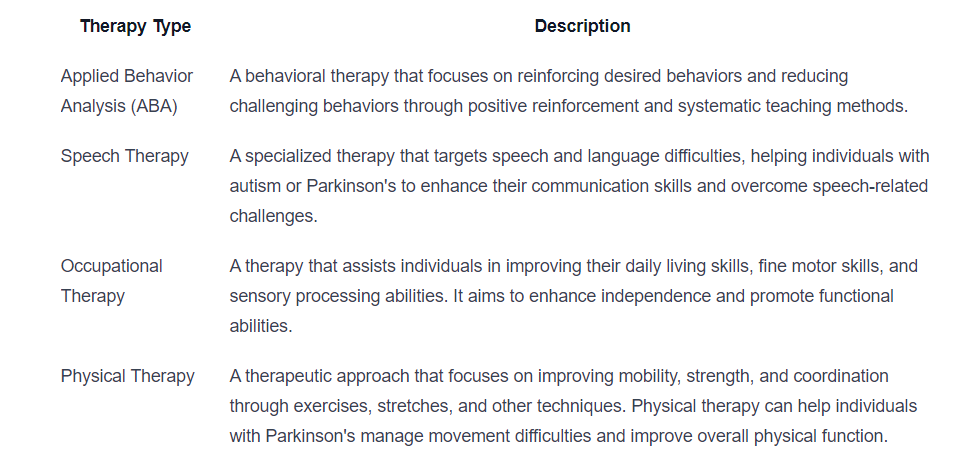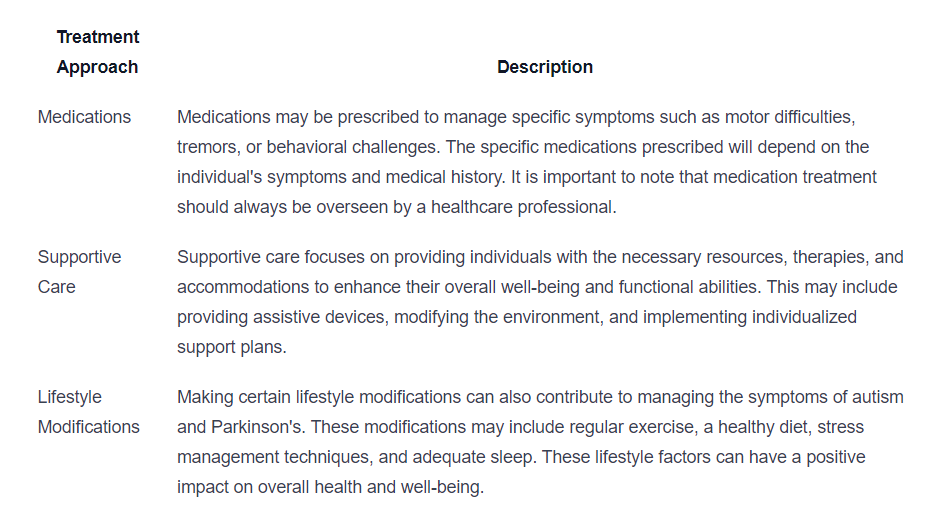What Do Autism and Parkinson's have in Common?
Uncover the shared features of autism and Parkinson's. Explore genetic links, neurological implications, and treatment approaches.

Autism and Parkinson's: A Comparative Analysis
In order to gain a deeper understanding of the connections between autism and Parkinson's, it is important to first comprehend each condition individually. By examining their shared features, we can begin to unravel the mystery behind the relationship between these two complex disorders.

Understanding Autism and Parkinson's
Autism, also known as Autism Spectrum Disorder (ASD), is a neurodevelopmental disorder that affects social interaction, communication, and behavior. It is typically diagnosed in early childhood and can vary widely in its presentation and severity. Individuals with autism often experience challenges in social interactions, repetitive behaviors, and sensory sensitivities.
On the other hand, Parkinson's disease is a neurodegenerative disorder that primarily affects movement. It is characterized by symptoms such as tremors, stiffness, slowness of movement, and impaired balance. Parkinson's is caused by a loss of dopamine-producing cells in the brain, leading to disruptions in motor control and other non-motor symptoms.
Exploring the Shared Features
While autism and Parkinson's may seem distinct at first glance, there are several shared features that have caught the attention of researchers and clinicians alike. These commonalities provide valuable insights into the underlying mechanisms of both conditions.
One of the key areas of overlap is the involvement of genetic factors. Studies have revealed genetic links between autism and Parkinson's, suggesting that certain genes may contribute to the development of both disorders. Shared genetic mutations have been identified in genes associated with synaptic function, neuronal development, and dopamine regulation.
In terms of neurological implications, both autism and Parkinson's involve disruptions in brain function and connectivity. Individuals with autism often exhibit atypical patterns of brain activity and connectivity, particularly in regions involved in social cognition and emotional processing. Similarly, Parkinson's is characterized by the degeneration of dopaminergic neurons, leading to imbalances in neurotransmitters and impaired communication between brain regions.
Behavioral symptoms also demonstrate overlap between the two conditions. Motor skills and coordination difficulties are commonly observed in both autism and Parkinson's. Individuals with autism may experience challenges with fine and gross motor skills, while those with Parkinson's often struggle with movement coordination and tremors.
Another shared feature is related to emotional regulation and social interaction. Individuals with autism may have difficulties understanding and expressing emotions, as well as challenges in social communication. Similarly, those with Parkinson's may experience changes in mood, social withdrawal, and difficulties in interpreting non-verbal cues.
Understanding the shared features between autism and Parkinson's is crucial for advancing research, diagnosis, and treatment strategies for both conditions. By recognizing these similarities, researchers can investigate common underlying mechanisms and potentially identify novel therapeutic approaches.
In the next sections, we will delve deeper into the genetic factors, neurological implications, behavioral symptoms, and treatment approaches for autism and Parkinson's, providing a comprehensive analysis of these complex disorders.
Genetic Factors
When examining the shared features between autism and Parkinson's, genetic factors play a significant role. Understanding the genetic links and impact of genetic mutations is essential in unraveling the mystery behind these conditions.
Genetic Links Between Autism and Parkinson's
Research has revealed a complex interplay of genetic factors in both autism and Parkinson's. While these conditions are distinct, there are instances where they coexist within families, suggesting a potential genetic connection.
Studies have identified specific genes that are implicated in both autism and Parkinson's, albeit with different variations. For instance, alterations in the PARK2 gene have been associated with an increased risk of both conditions. Additionally, genes involved in dopamine regulation, such as the LRRK2 gene, have shown links to both autism and Parkinson's.
It is important to note that the genetic links between autism and Parkinson's are still being explored, and further research is needed to fully understand the extent of these connections.
Impact of Genetic Mutations
Genetic mutations can have profound effects on the development and functioning of the brain, contributing to the manifestation of both autism and Parkinson's.
In autism, various genetic mutations have been implicated, affecting genes involved in neural development, synaptic connectivity, and neurotransmitter regulation. These mutations disrupt the normal functioning of the brain, leading to the characteristic behavioral and cognitive symptoms associated with autism.
Similarly, in Parkinson's, specific genetic mutations have been identified, particularly in genes involved in dopamine production and regulation. These mutations can disrupt the normal balance of neurotransmitters in the brain, resulting in the motor symptoms and other manifestations of Parkinson's.
While there are shared genetic factors between autism and Parkinson's, it is important to recognize that not all individuals with autism will develop Parkinson's, and vice versa. The presence of genetic mutations increases the risk but does not guarantee the development of either condition.
Understanding the genetic factors and impact of genetic mutations in both autism and Parkinson's is an ongoing area of research. By unraveling the complex genetic underpinnings, scientists hope to gain further insights into the shared features and potential therapeutic approaches for these conditions.
Neurological Implications
When examining the shared features of autism and Parkinson's, it is important to consider the neurological implications of these conditions. Both autism and Parkinson's are neurological disorders that impact brain function and neurotransmitter activity.
Brain Function and Connectivity
In individuals with autism and Parkinson's, there are notable differences in brain function and connectivity. In autism, studies have shown that there are abnormalities in brain structure and organization, particularly in areas responsible for social interaction, communication, and sensory processing. These differences in brain connectivity can contribute to the characteristic symptoms of autism, such as difficulties in social interaction and communication.
Similarly, Parkinson's disease affects brain function, primarily in regions responsible for movement control. The degeneration of dopaminergic neurons in the substantia nigra leads to a decrease in dopamine levels, resulting in motor symptoms such as tremors, rigidity, and bradykinesia.
Dopamine Levels and Neurotransmitters
One of the key shared features between autism and Parkinson's is the involvement of neurotransmitters, particularly dopamine. Dopamine is a vital neurotransmitter that plays a crucial role in various brain functions, including motor control, reward systems, and emotional regulation.
In autism, there is evidence of altered dopamine levels and dysregulation of the dopaminergic system. This can contribute to difficulties in emotional regulation, repetitive behaviors, and attention deficits observed in individuals with autism.
In Parkinson's disease, the loss of dopaminergic neurons leads to a significant reduction in dopamine levels. This dopamine depletion disrupts the normal functioning of the basal ganglia, resulting in the motor symptoms associated with Parkinson's.
To summarize the neurological implications of autism and Parkinson's:

Understanding the neurological aspects of autism and Parkinson's is crucial for gaining insights into the shared features and underlying mechanisms of these conditions. By further exploring the genetic factors, behavioral symptoms, and treatment approaches, we can deepen our understanding and potentially uncover new avenues for research and therapeutic advancements.
Behavioral Symptoms
Autism and Parkinson's share some common behavioral symptoms, although they manifest differently in each condition. Understanding these shared features can provide insights into the overlapping aspects of these neurodevelopmental and neurodegenerative disorders.
Motor Skills and Coordination
Both autism and Parkinson's can affect motor skills and coordination, albeit in distinct ways. Individuals with autism often exhibit difficulties with fine motor skills, such as writing, tying shoelaces, or using utensils. They may also struggle with gross motor skills, which involve activities like running, jumping, or catching a ball.
Parkinson's, on the other hand, primarily impacts motor skills through a movement disorder known as bradykinesia, which refers to slow movement and a general loss of spontaneous motor activity. This can lead to challenges in performing everyday tasks, such as walking, writing, or buttoning clothes.
To illustrate the differences in motor symptoms between autism and Parkinson's, the following table provides an overview:

Emotional Regulation and Social Interaction
Emotional regulation and social interaction are areas where both autism and Parkinson's can present challenges, albeit in distinct ways.
Individuals with autism often struggle with understanding and expressing emotions, leading to difficulties in regulating their own emotions. They may have difficulty recognizing facial expressions or understanding social cues, which can impact their ability to engage in meaningful social interactions.
Parkinson's can also affect emotional regulation and social interaction. The condition can lead to changes in mood, including depression and anxiety. Additionally, the motor symptoms of Parkinson's, such as bradykinesia and tremors, can impact an individual's ability to communicate effectively and engage in social interactions.
To summarize the behavioral symptoms related to emotional regulation and social interaction in autism and Parkinson's, refer to the table below:

Understanding the shared behavioral symptoms between autism and Parkinson's can help researchers and healthcare professionals gain a deeper understanding of the underlying mechanisms and develop targeted interventions for both conditions. Further research is essential to unravel the complexities of these disorders and improve the lives of individuals affected by autism and Parkinson's.
Treatment Approaches
When it comes to addressing the challenges posed by autism and Parkinson's, various treatment approaches are available. These approaches aim to improve the quality of life for individuals with these conditions and manage their symptoms effectively. In this section, we will explore the therapeutic interventions, medications, and management strategies commonly utilized for both autism and Parkinson's.
Therapeutic Interventions for Autism and Parkinson's
Therapeutic interventions play a crucial role in the treatment of both autism and Parkinson's. These interventions are designed to address specific symptoms and improve overall functioning. Here are some commonly employed therapeutic approaches for both conditions:

These therapeutic interventions are tailored to the specific needs of each individual, taking into account their unique symptoms and challenges. The goal is to enhance their overall well-being, functional abilities, and quality of life.
Medications and Management Strategies
In addition to therapeutic interventions, medications and management strategies are utilized to address the symptoms associated with autism and Parkinson's. These approaches are aimed at alleviating specific symptoms and improving daily functioning. Here are some common medications and management strategies employed for both conditions:

It is important to consult with healthcare professionals or specialists to determine the most appropriate treatment approach for individuals with autism or Parkinson's. Treatment plans should be tailored to the unique needs of each individual, taking into consideration their specific symptoms and challenges.
By utilizing a combination of therapeutic interventions, medications, and management strategies, individuals with autism and Parkinson's can work towards improved symptom management and an enhanced quality of life. Ongoing research and advancements continue to contribute to the development of more effective treatment approaches for these conditions.
Research and Future Outlook
As scientists continue to delve into the complexities of autism and Parkinson's, ongoing studies and discoveries provide valuable insights into these conditions. By understanding the shared features and underlying mechanisms, researchers aim to develop potential breakthroughs in treatment.
Ongoing Studies and Discoveries
Ongoing studies focused on autism and Parkinson's are shedding light on various aspects of these conditions, including their genetic and neurological implications, as well as behavioral symptoms. Researchers are exploring the intricate relationship between these disorders, aiming to uncover commonalities and potential targets for intervention.
One area of research involves investigating the genetic links between autism and Parkinson's. Through extensive genetic analysis, scientists have identified specific genetic mutations that contribute to the development of both conditions. By understanding these genetic links, researchers hope to gain a deeper understanding of the biological pathways involved and identify potential therapeutic targets.
Neurological studies are also providing valuable insights into the shared features of autism and Parkinson's. Researchers are examining brain function and connectivity to identify similarities and differences in how these conditions affect neural networks. Additionally, investigations into dopamine levels and other neurotransmitters are uncovering the role these chemical messengers play in both autism and Parkinson's.
Potential Breakthroughs in Treatment
While significant advancements have been made in understanding autism and Parkinson's, the search for effective treatments remains ongoing. However, promising breakthroughs are on the horizon.
In the realm of autism treatment, therapeutic interventions are being developed to address specific symptoms and challenges faced by individuals with autism. These interventions encompass a wide range of approaches, including behavioral therapy, social skills training, and sensory integration therapy. By tailoring treatment to the unique needs of individuals with autism, researchers are working towards improving their quality of life and overall well-being.
Similarly, in the case of Parkinson's, researchers are exploring various treatment strategies to manage symptoms and slow down disease progression. Medications that target specific neurotransmitters, such as dopamine, are commonly prescribed to alleviate motor symptoms. Additionally, management strategies, including physical therapy and deep brain stimulation, show promise in improving motor function and overall quality of life for individuals with Parkinson's.
Continued research and collaboration among scientists, clinicians, and individuals affected by autism and Parkinson's hold the key to future breakthroughs in treatment. By unraveling the shared features and underlying mechanisms of these conditions, researchers aim to develop targeted therapies that address the unique challenges faced by individuals with autism and Parkinson's. Through ongoing studies and discoveries, the scientific community is dedicated to making significant strides in improving the lives of those affected by these conditions.
Sources
https://www.crossrivertherapy.com/autism/autism-and-parkinsons
https://www.ncbi.nlm.nih.gov/pmc/articles/PMC10109258/
https://www.abtaba.com/blog/autism-and-parkinsons
Similar articles
We’re here to help you

Our team is here to assist you in this process. Contact us for any assistance.
it’s easy to apply
We Accept Most Insurances
Our in-network insurance partnerships make ABA therapy more accessible to families throughout our service areas.







Our Insurance Process
We'll request your insurance details to help us verify your plan's coverage for ABA therapy. Once we've received this information, we'll walk you through your benefits, including copayments, deductibles and out-of-pocket maximums, so you know what to expect in advance.
Our team will then handle the preauthorization and all the necessary paperwork.
.svg)





















.jpeg)


































.jpeg)




.jpeg)







.jpeg)











.jpeg)
















